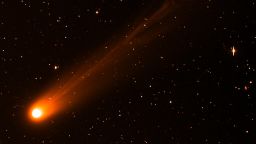An interstellar comet named 3I/ATLAS has recently completed its closest pass to the sun, coming within approximately 126 million miles (about 203 million kilometers) of our star. This significant event places the comet on an outgoing trajectory, although it will remain within our cosmic neighborhood for a while longer. Currently, the comet is obscured by the sun from the perspective of ground-based telescopes, but astronomers expect to observe it again within a few weeks. Darryl Seligman, an assistant professor in the department of physics and astronomy at Michigan State University, has indicated that stargazers with telescopes should be able to spot 3I/ATLAS in the predawn sky starting on November 11, 2023.
As astronomers continue to monitor the comet, they anticipate that the opportunity to study it will last for several months before it begins to leave our solar system. The comet is expected to make its closest approach to Earth on December 19, 2023, when it will come within approximately 168 million miles (around 270 million kilometers). The European Space Agency has confirmed that 3I/ATLAS poses no threat to our planet.
Since its discovery on July 1, 2023, 3I/ATLAS has been a focal point for researchers, being only the third identified interstellar object to traverse our solar system. Each observation contributes valuable insights into the comet’s characteristics and how it may differ from those formed within our own solar system.
Understanding the Composition of 3I/ATLAS
Comets are often described as “dirty snowballs,” consisting of a solid core made from ice, dust, and rocky material. As a comet approaches a star like the sun, it experiences heat that triggers the release of gas and dust, forming its distinctive tail. The study of 3I/ATLAS is particularly intriguing, as scientists hope to gather data about its composition to better understand the conditions of its original star system.
“When it gets closest to the sun, you get the most holistic view of the nucleus possible,” Seligman noted. Understanding the composition of the volatiles released from the comet can reveal information about the primordial materials from which it formed.
Utilizing advanced observational tools, including the Hubble Space Telescope and the James Webb Space Telescope, scientists have detected various substances emanating from 3I/ATLAS. Preliminary findings indicate the presence of carbon dioxide, water, carbon monoxide, and carbonyl sulfide, as well as water ice, as the comet nears the sun. A study co-authored by Seligman and Aster Taylor, a doctoral student at the University of Michigan, estimated that the comet is between 3 billion to 11 billion years old. For context, our solar system is approximately 4.6 billion years old.
Seligman emphasized that carbon dioxide sublimates — transitioning directly from solid to gas — more readily than many other elements. This characteristic suggests that 3I/ATLAS likely has not come close to another star before its encounter with the sun.
Future Observations and Collaborations
Although 3I/ATLAS was no longer visible to ground-based telescopes in October, various space missions, including PUNCH (Polarimeter to Unify the Corona and Heliosphere) and SOHO (Solar and Heliospheric Observatory), continued to track the comet. Notably, the object made its closest approach to Mars on October 3, 2023, coming within 18.6 million miles (around 30 million kilometers) of the planet and its orbiting spacecraft.
Due to a government shutdown impacting data sharing for NASA missions observing the comet since October 1, the European Space Agency has taken the lead in monitoring. The Mars Express and ExoMars Trace Gas Orbiter managed to capture images of 3I/ATLAS in October. Despite the challenges posed by the comet’s faintness — noted to be 10,000 to 100,000 times fainter than typical targets — the ExoMars mission succeeded in identifying the comet as a fuzzy white dot.
Looking ahead, the ESA’s Jupiter Icy Moons Explorer (Juice) is scheduled to attempt observations of 3I/ATLAS in November. Although the comet will be farther from the spacecraft than during previous observations, astronomers are eager to gather more data, even if the results may not be available until February due to the spacecraft’s data transmission rate.
Seligman remains optimistic about the scientific potential of the remaining observational opportunities. “We’ve got several more months to observe it,” he stated. “And there’s going to be amazing science that comes out.” The ongoing study of 3I/ATLAS promises to enhance our understanding of interstellar objects and their roles within the broader cosmos.







